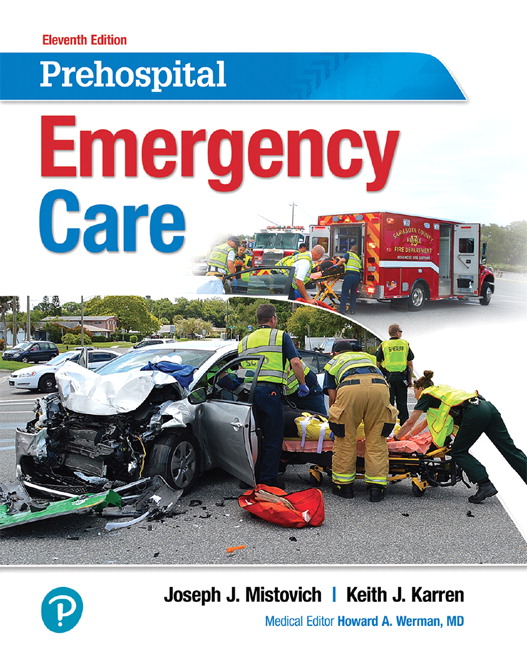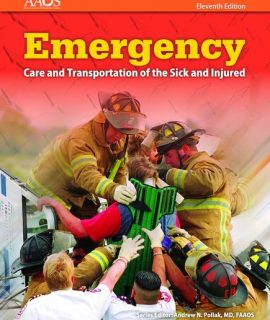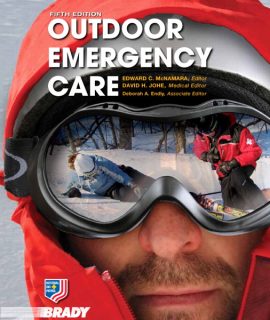Prehospital Emergency Care, 11th Edition
$174.99
The most complete resource for EMT training
Comprehensive in scope and student-friendly, Prehospital Emergency Care conveys the “WHY” behind the signs and symptoms students observe and the services they provide. Through a solid foundation of pathophysiology, students will learn to quickly identify immediate life threats and deliver excellent emergency care.
The 11th edition continues to meet and exceed the National EMS Education Standards. It has been thoroughly updated to reflect the latest and best practices for emergency medical services in the US, including conforming to the latest American Heart Association guidelines. Spine motion restriction, naloxone administration, sepsis, stroke screening tools, human trafficking, active shooter, domestic violence, and clinical decision-making with regard to oxygen administration are just a few of the updates readers will discover in this hallmark text.
- “Assessment Tips” and “Assessment Summaries” offer clinical insights needed to accurately evaluate medical conditions and link findings to conditions.
- “Pathophysiology Pearls” explain the causes of medical conditions and injuries so EMTs can best assess signs and symptoms and make the right decisions for each patient.
- “Case Study” and “Case Study Follow-Up” emphasize key concepts from the chapter, provide a link between the text and real-life situations, and deliver accompanying pathophysiology notes that explain the “why” of signs, symptoms, and recommended emergency care.
- “Drug Profiles” give specifications for common medications, including medication name, indications, contraindications, medication form, dosage, administration, actions, side effects, and reassessment protocols.
- “EMT Skills” and “Emergency Care Protocols” provide step-by-step procedures to help EMTs deliver safe, effective emergency care based on proven methods.
- “Emergency Care Algorithms” visually depict procedural steps, further illuminating care and assessment processes.
- “Critical Findings” throughout Chapter 13 (“Patient Assessment”) explain conditions, signs, and symptoms to expect at every step of the assessment, what might be causing them, and how to address them.
Reflects the latest and best medical knowledge and practices in emergency medical services
- UPDATED! Course of treatment for spinal trauma has been revised to emphasize spine motion restriction rather than immobilization whenever possible spinal (column or cord) injury is suspected.
- UPDATED! Latest American Heart Association (AHA) guidelines inform strategies for providing excellent patient care.
- UPDATED! Vital signs values throughout the text have been revised to reflect guidelines of the AHA and American Academy of Pediatrics.
- UPDATED! Recommendations for oxygen administration in medical patients and trauma patients have been revised to reflect standards of the AHA and the American College of Surgeons.
- NEW! Extensive new section on sepsis and the cause of septic shock now appear in Chapter 15, “Shock & Resuscitation.”
- NEW! Pharmacology coverage has been added. Topics covered include naloxone, manual administration of epinephrine, and cautions regarding the administration of oxygen.
- EXPANDED! “Respiratory Emergencies”chapter has been expanded with information on breathing distress (respiratory distress/failure/arrest), obstructive pulmonary disease (asthma, emphysema, chronic bronchitis), and pulmonary embolism, pulmonary edema, and cystic fibrosis.
- UPDATED! Altered mental status coverage has been greatly expanded to include AHA’s Stroke Chain of Survival, FAST mnemonic, TIA, cryptogenic stroke, and signs and symptoms associated with anterior circulation stroke and posterior circulation stroke.
Offers a wealth of study aids to help students master the material and pass exams
- Objectives inform chapter-by-chapter content and meet National EMS Education Standards and instructional guidelines.
- Key terms appear at the start of each chapter (with page references), in bold type within the chapter, and in the end-of-book glossary.
- Multimedia exercises appear in MyLab BRADY, including related web links, animations, and videos.
- NEW! Photos and illustrations have been added throughout the book.
Categories
- Firehall Mall
- First Alert Smoke & Carbon Monoxide Alarms
- Coming Soon – Pre-Order
- ATS Online Training
- NFPA Standards & Fire Codes
- Ontario Codes
- Fire Safety & Public Education Materials
- Fire Service & Rescue
- Fire Investigator
- Fire Inspection & Code Enforcement
- Apparatus Driver/Operator
- Fire Protection/Systems & Apparatus
- Vehicle Extrication/Highway Safety
- Hazardous Materials
- Industrial / Facility
- Building & Life Safety
- Fitness / Wellness / Health & Safety
- Wildland
- Management / Leadership / Advancement
- Firefighter Entry Level
- Emergency Medical Service
- Emergency Management/Terrorism
- Firefighting Novels/History/Memoirs
- Deals & Steals






